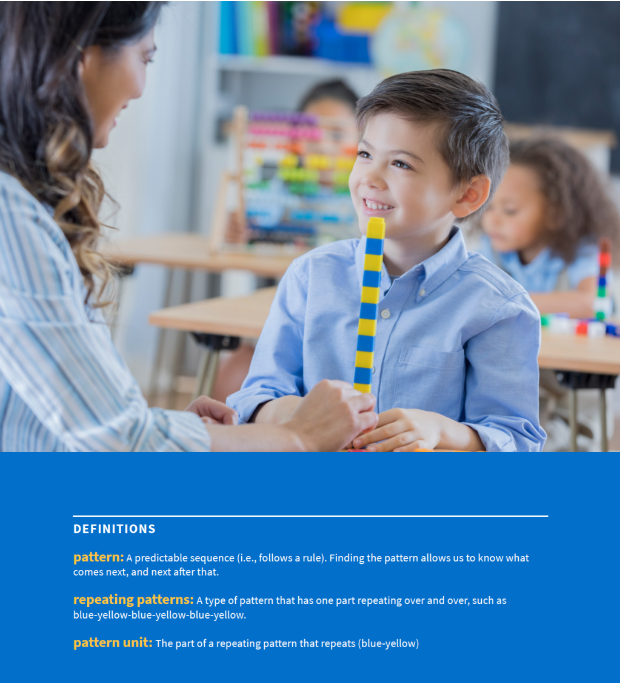SUPPORTING EARLY MATH KNOWLEDGE THROUGH PATTERNING
By Dr. Bethany Rittle-Johnson & Erica Zippert, Vanderbilt University
Quick links
- Number Skills: How to Help Your Preschooler Practice Four Key Number Skills at Home
- Repeating Patterning Skills: How to Help Your Preschooler Practice Four Key Patterning Skills at Home
- Math Books, Games & Websites for Families
- Math Tips for Families Featuring Card Games, Blocks, and Beads
- Patterning Tips for Parents and Teachers
 NOTICE AND MAKE PATTERNS TOGETHER
NOTICE AND MAKE PATTERNS TOGETHER
2. Make patterns with movements or music. Encourage children to create their own patterns. “Let’s make a pattern with our bodies. Clap, Clap, Stomp, Clap, Clap, Stomp!”
3. Make patterns with toys, blocks, shapes, beads, and more, and encourage children to make their own patterns.
4. Make patterns with everyday objects in your home or outside, and ask children to make their own patterns.
IDEAS FOR PATTERNING ACTIVITIES
1. Vary the pattern unit! Start with easier pattern units, and make them harder as your children learn!
- Easy: Start with AB patterns

- Hard: Move to more difficult patterns, like AAB, ABB, AABB, ABC

2. Do Different Patterning Activities!
A. Easy: First, practice copying, creating, and completing patterns. Children copy patterns made by others, create their own patterns and complete patterns that have missing elements.
B. Medium: Next, children can practice extending patterns.
You can ask, “Can you keep the pattern going?” or “What comes next?” including for patterns they created.
C. Hard: Children can also learn to abstract patterns and to find the rule for each pattern.
- Abstracting patterns includes making the same type of pattern, using different materials. For example, you could create a pattern using blocks and ask children to make the same kind of pattern using other blocks or shapes. The patterns are the same because they follow the same rule. Be sure to name the rule.

Finding the rule for the patterns helps children learn to identify which part of the pattern repeats. You can ask your child to identify the rule by asking “What part repeats over and over?” and “What is the rule for this pattern?”
3. Talk About the Patterns, Using Your Hands Too
A. You can help your children understand patterns by using abstract labels and pointing to the pattern unit.
You can label using letters: “The pattern goes A-A-B. And then it repeats, A-A-B. It’s an AAB pattern,” while pointing to each pattern unit.
You can also label using numbers: “This is a 2-1 pattern because it has 2 squares and 1 circle, and that repeats over and over!” while pointing to the first two items and then the 3rd item, and then repeating this for the second pattern unit.
B. Ask your child to tell you the pattern.
“How do you know it’s a pattern?”
“Why do you think that’s a pattern?”
C. Ask your child “Is this a pattern?” and help them to understand why or why not
For example, “We can’t see a pattern, because there is not a part that repeats! We don’t know what comes next.”
FINDING PATTERNS IN NUMBERS
Numbers follow rules, just like patterns follow rules. Helping children notice patterns in numbers can help them to understand that numbers follow rules, too.
- Repeating patterns in number system (e.g., the one’s digits repeat in each decade). Ask children to look for patterns in number grids or number lines.

2. Growing patterns: Items increase or decrease following a rule, such as add 1.
A. When you count, the next number word means you added one more.
“There’s a pattern in our stairs! Each step has one more cube than the one before! You can use counting to figure out what comes next.”
B. Growing patterns in popular books and songs.
